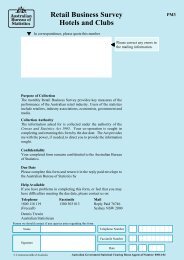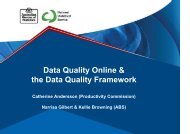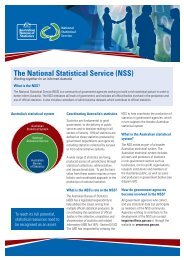SAE Manual Sections 1 to 4_1 (May 06).pdf - National Statistical ...
SAE Manual Sections 1 to 4_1 (May 06).pdf - National Statistical ...
SAE Manual Sections 1 to 4_1 (May 06).pdf - National Statistical ...
You also want an ePaper? Increase the reach of your titles
YUMPU automatically turns print PDFs into web optimized ePapers that Google loves.
A Guide <strong>to</strong> Small Area Estimation - Version 1.1 05/05/20<strong>06</strong><br />
1.4 What are the primary uses for Small Area Estimates?<br />
Federal, state and local government bodies involved in program funding / evaluation or<br />
regional planning are typically the primary users of ABS small area data. They require<br />
estimates of specified accuracy <strong>to</strong> assist them in making informed decisions on how <strong>to</strong><br />
allocate resources or apply for additional resources. The need for government services<br />
<strong>to</strong> justify their decision making and be accountable <strong>to</strong> the community is seen as a very<br />
important fac<strong>to</strong>r.<br />
Small area estimates are often used by program administra<strong>to</strong>rs <strong>to</strong> determine or<br />
benchmark their funding allocations. Without the small area information, the<br />
administra<strong>to</strong>rs have difficulty in assessing the actual need for goods and services in each<br />
area. This can result in undesirable scenarios such as "the squeaky wheel gets the<br />
grease", whereby interest groups or areas which are most vocal receive a greater share of<br />
the funding allocations. Small area estimates provide detailed information on each area<br />
allowing for objective and informed decision making.<br />
Local government demand for small area data has also increased as they become<br />
increasingly aware and interested in the role statistics can play in informing them about<br />
what is happening in their own jurisdictions.<br />
1.5 When should Small Area Estimates be Produced?<br />
Small area estimates should only be produced when there is strong and justified user<br />
demand as well as no alternate data at the small area level that will serve the required<br />
purpose. In addition there needs <strong>to</strong> be adequate survey and auxiliary data <strong>to</strong> ensure that<br />
the outputs produced will be of sufficient quality <strong>to</strong> fit their intended purpose.<br />
Small area estimates should primarily be considered where key policy making decisions<br />
require discerning between relative needs of different small areas and such information<br />
does not currently exist or requires updating (eg. Disability data). To develop small area<br />
estimates, significant resources in staff time <strong>to</strong> develop, check and get approval for<br />
release is needed. The complexity of most small area estimation exercises and the<br />
difficulty in validating the reliability of the output makes it very difficult <strong>to</strong> fully au<strong>to</strong>mate<br />
the production process. To a large extent, each small area undertaking has <strong>to</strong> be tailored<br />
<strong>to</strong> the nature and specifics of the problem at hand. Therefore, care needs <strong>to</strong> be taken <strong>to</strong><br />
ensure the need for the small area estimates warrants the effort required.<br />
The first step is <strong>to</strong> discuss with the users <strong>to</strong> see if state or part of state estimates would<br />
be adequate. If there is not much variation between the small areas then more broad<br />
estimates would be adequate. It is also worth investigating any sources of administrative<br />
data that can be used as auxiliary data for a small area model. Finally, it is worthwhile<br />
checking that the chosen small area model fitted <strong>to</strong> the data is appropriate for that data<br />
and inherent assumptions in the model do at least approximately hold. For example<br />
fitting a linear model <strong>to</strong> the data would require that the errors are identically and<br />
independently distributed with zero mean and constant variance. It is therefore prudent<br />
<strong>to</strong> check such assumptions are reasonable and have been satisfied before estimating the<br />
model.<br />
Australian Bureau of Statistics 9








